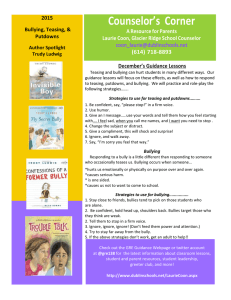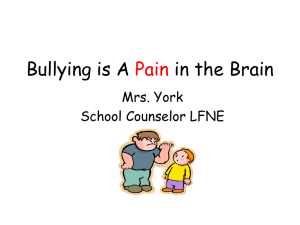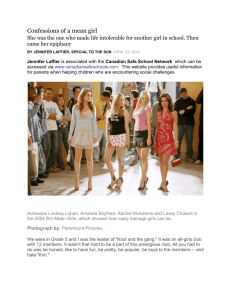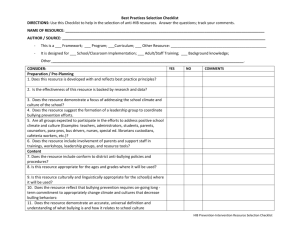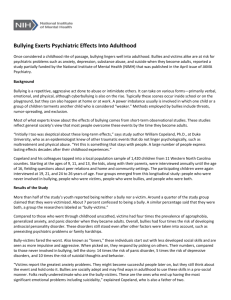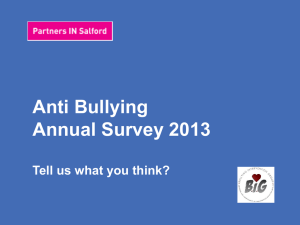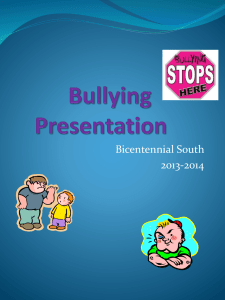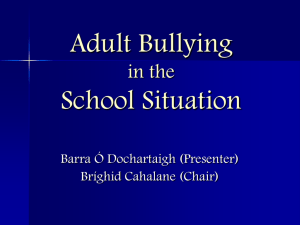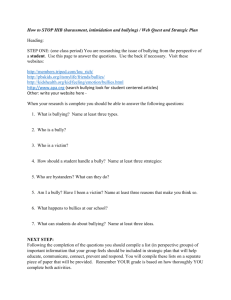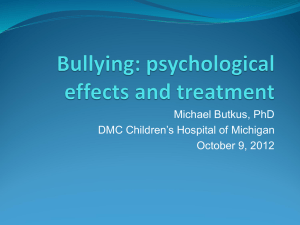Bullying 101: A Presentation for Parents
advertisement
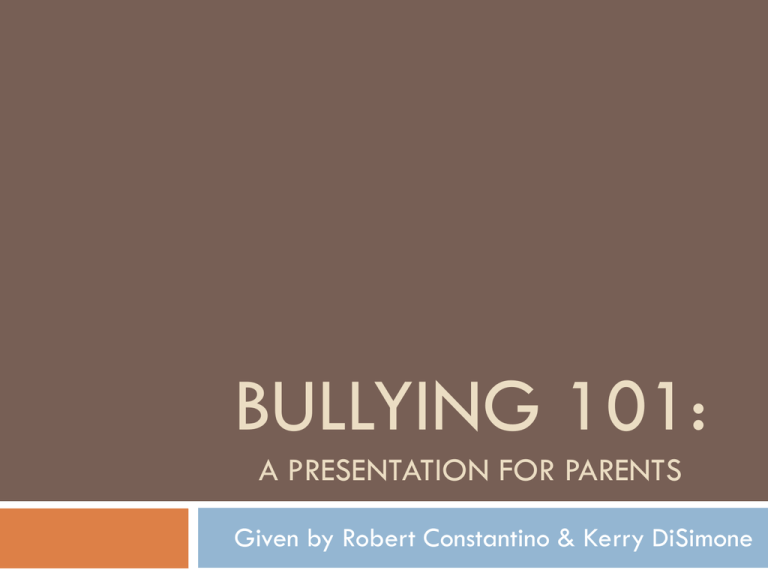
BULLYING 101: A PRESENTATION FOR PARENTS Given by Robert Constantino & Kerry DiSimone Definition of HIB According to the NJ 2011 Anti-Bullying Bill of Rights "Harassment, intimidation or bullying" means any gesture, any written, verbal or physical act, or any electronic communication, whether it be a single incident or a series of incidents, that is reasonably perceived as being motivated either by any actual or perceived characteristic, such as race, color, religion, ancestry, national origin, gender, sexual orientation, gender identity and expression, or a mental, physical or sensory disability, or by any other distinguishing characteristic… HIB Definition (cont’d) According to the NJ 2011 Anti-Bullying Bill of Rights that takes place on school property, at any school-sponsored function, on a school bus, or off school grounds that substantially disrupts or interferes with the orderly operation of the school or the rights of other students and that: a. a reasonable person should know, under the circumstances, will have the effect of physically or emotionally harming a student or damaging the student's property, or placing a student in reasonable fear of physical or emotional harm to his person or damage to his property; b. has the effect of insulting or demeaning any student or group of students; or c. creates a hostile educational environment for the student by interfering with a student’s education or by severely or pervasively causing physical or emotional harm to the student. Bullying Happens in Four Ways Verbal Physical Blocking someone’s path, physical restraint, pushing/kicking, hazing Sexual Teasing, jokes, ignoring/isolation, gossip, threats Teasing, touching, slapping, pictures, emails, graffiti, sexual assault Property Hiding belongings, theft, arson, extortion, vandalism, destruction The Dynamics of Bullying BULLY VICTIM BYSTANDER Bullies Aggressive Bullies Passive Bullies (Anxious Bullies) Most common type – Physically strong, impulsive, hot-tempered, confident, lacks empathy Motivated by power and the desire to dominate others Tend to be insecure, are far-less popular than aggressive bullies, have low selfesteem, unhappy home lives Won’t typically initiate a bullying situation but readily joins in once one is under way Bully-victims Small percentage who have been seriously bullied themselves More likely to be both anxious and depressed Typically provoke others who are weaker than they are Victims Passive Victims Do not directly provoke bullies Socially withdrawn, often seem anxious, depressed, and fearful Few, if any, friends – lonely and sad Provocative Victims Often behave in ways that arouse negative responses from those around them, such as anger, irritation, and exasperation Possess a cluster of characteristics that are likely to disrupt a classroom and lead to social rejection by peers, including irritability, restlessness, off-task behavior, and hostility Bystanders Most students fall into this category Are afraid to associate with the victim Fear reporting bullying incidents Experience feelings of guilt and helplessness Are drawn into bullying behavior Feel unsafe HAVE THE MOST POWER TO CHANGE THE BULLYING SITUATION! Is My Child a Target? The Warning Signs… Reluctant to go to school – complains of illness/headaches before school Does not want to ride school bus Experiencing a sudden drop in grades Coming home hungry (missing lunch) Experiencing nightmares, wetting the bed, having difficulty sleeping or excessively sleeping Refusing to leave home Waiting to get home to use the bathroom Acting nervous when an unfamiliar child approaches Showing increased anger or resentment with no obvious cause Talking about feeling lonely or about difficulty making friends Reluctant to defend himself/herself when teased or criticized Bruised, cut, or bearing scrapes that are not easily explained What Can You Do to Help? Do not over- or under- react Do not dismiss the experience Do not place blame on the child Encourage child to talk about the incident Provide extra support and encouragement Encourage child to talk to another adult If possible, encourage child to stay away from the bully as school deals with the situation. Discussion Prompts Trying to have your child say more than “Greg was mean to me” can be a feat. Try these questions to get more specific information: What would an instant replay of what happened look like? Describe what other people saw and heard during the incident. Why today? Why do you think he/she bullied you? What was the most frustrating part of the experience? If this happened again, what would you do differently? Tattling vs. Telling Tattling If it will only get another person in trouble, then don’t tell me. Telling If it will get you or another child out of trouble, tell me. If it is both, I need to know. Is My Child a Bully? The Warning Signs… [Adapted from Why Doesn’t Anybody Like Me? (Marano, 1998) Positive views towards violence/ aggression Marked need to control and dominate others and situations Manipulates the relationships of others (to be mean) Hot tempered, impulsive, easily frustrated Often test limits or break rules Good at talking their way out of difficult situations Show little sympathy toward others Quick to interpret accidents or other neutral events as deliberate acts of hostility Have two or three friends who are also aggressive What Can You Do to Help? Take problem seriously Question and listen attentively Seek reasons behind bullying behavior Make it clear that conduct must stop immediately What if My Child is a Bully? Ways to get your child back on track… Teach your child how to handle frustration Make sure aggressive behaviors are recognized as such Teach your child better ways to handle anger Model non-aggressive behaviors for your child Teach your child conflict resolution skills Shake up your interaction with your child The Importance of Empathy Model an awareness of how others may be feeling and your reaction to their emotions Repeatedly ask these questions: How is that person feeling? How can you tell he/she is feeling that way? How would you feel if it happened to you? Help your child become more effective at reading the body language, tone of voice, and non-verbal communication of others Empathy is the cornerstone of building and maintaining successful relationships. Bullying vs. Peer Conflict Normal Peer Conflict Equal power or are friends Happens occasionally Accidental Not serious Equal emotional reaction Not seeking power Remorse-will take responsibility Effort to solve the problem Bullying Imbalance of power Repeated negative actions Intentional Physical or emotional harm Unequal emotional reaction Seeking control/material things No remorse-blames target No effort to solve the problem Answers to the Bully Quiz Q&A Time
